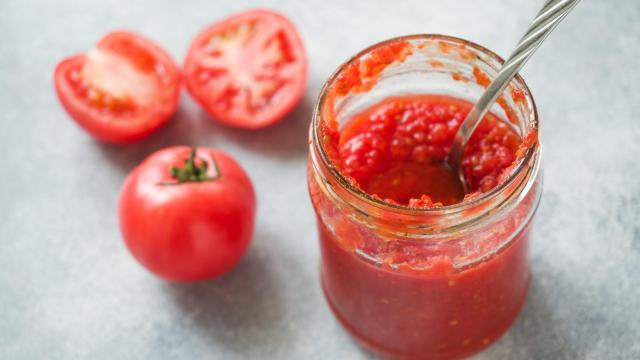Like any Italian-American with a trained affinity for tomatoes, Labour Day in the US doesn’t just signal the end of summer. Much more dire: It’s the last call for summer tomatoes. Those ripe, tangy-sweet heirlooms that call to you at farmers markets and grocery stores will soon be a thing of the past. If you have a food-focused social media algorithm like mine, the recipe round-ups are making your grid look like tomato-patterned wallpaper. (To be clear, I’m not complaining.)
But why mourn the end of summer when you can prepare for autumn? Take initiative and start preparing for those soups and sauces you’ll count on to warm your soul when the temperature drops. There is no need to eat your beefsteaks like apples until you find yourself bent over with acid reflux. Simply can those ripe tomatoes and eat them all year long.
For me and my family, and so many other Italian and Italian immigrant families, this idea is taken to an extreme. Picture a table full of bushel upon bushel of plum tomatoes, a sauce pot large enough to feed a Navy ship, and a platoon of relatives ready to put in the work. It wasn’t just my grandmother’s depression-trained mindset that propelled her to preserve the harvest and teach us to do the same. “Tomato Day” or “Passata Day” is a yearly tradition practiced by Italian families around the world. It’s not just a seasonal exercise, but a familial event. I can still picture the cans of red liquid gold that lined my grandmother’s pantry cabinets, where they could be retrieved for a bolognese at a moment’s notice. Luckily, you don’t need an army of Italian aunts and uncles to make your passata or sauce. You can tackle the project on your own, albeit on a smaller scale.
The difference between tomato passata and tomato sauce
To be clear, the liquid gold on my grandmother’s shelves was a bare-bones pasta sauce, but many families opt to make a simple passata — the bright and fresh foundation of what will become a sauce. Tomato passata is a pantry staple in Italy — the uncooked pulp of a tomato, separated from skin and seeds. It is 100% tomato, free of additives, intended to preserve the concentrated sweetness of the fruit in its beautifully fresh form. Sometimes salt is added, but other than that, it is purely the bright, silky essence of tomato, canned at the absolute peak. It can be used for any recipe that calls for diced or canned tomatoes (or even for Bloody Mary’s), resulting in a sweet and vibrant sauce or dish, due to its high concentration of pulp.
In our family, we typically take the passata one step further, simmering it on the stovetop with salt and basil until it reduces down to a thicker, lightly caramelised sauce. Once canned, it’s ready to use in heartier sauces, soups, and stews. It can even be used as a ready made pizza sauce. Similar to passata, we use it for any recipe that calls for sauce, diced or canned tomatoes, or for a splash of acidity, adjusting the volume and salt content accordingly.
How to make tomato passata and basic tomato sauce
You will need:
- Glass canning jars with new lids and screw bands.
- A large sauce pot
- A tomato press or food mill (you can also use a fine strainer and wood spoon in a pinch)
- A funnel for filling the jars
- Jar lifters or large tongs (wrap tongs with thick rubber bands for extra grip)
- Tomatoes (Roma or plum tomatoes tend to produce the most sauce)
- Fresh basil leaves (optional)
- Coarse salt
To make tomato passata (2 kg of tomatoes typically makes 1.5 quarts of passata):
- Clean and sterilise jars: Submerge both lids and jars in boiling water for 10 minutes, remove, then keep them clean and covered.
- Wash and dry the tomatoes. Then cut the tomatoes in quarters, removing any unripe parts.
- Cook down your tomatoes to remove excess water and help the skin separate from the fruit: Fill a large pot with as many tomatoes as you can fit, but do not add water! Place the pot over low-medium heat, stirring often. Once they come to a boil, simmer for about 15 minutes or until the tomatoes begin to break apart and their juice pools at the base.
- Strain the tomatoes from the excess juice.
- Mill the tomatoes: If using one, place the vegetable mill on top of another large pot. Begin ladling the strained tomatoes through the mill or tomato press. You can pass them through more than once to extract as much pulp as possible.
At this point, you have tomato passata that is ready to be canned, or you can take things a few steps further and make sauce.
Basic Tomato Sauce: (For me, 1 kg of tomatoes typically makes 1 quart of sauce).
- To reduce the passata and make sauce, simmer it on the stove for 1-3 hours until it reaches the desired consistency. Add salt to taste.
- Fill the jars. Place 3 or 4 fresh, clean basil leaves on the bottom of each jar (optional). Fill each jar and seal well, wiping the lids dry before closing them shut.
- Seal the jars. Line the bottom of a large pot with a folded kitchen towel and arrange the jars around it to keep them from rattling together. Add enough water to cover the jars by 2 to 3 inches. Bring the water to a boil over high heat, then lower the heat to maintain a rolling boil. Boil the jars for 40 minutes, then turn off the heat and remove with tongs or jar lifters.
- Once the jars are room temperature, store in a cool, dry place for up to a year.

Leave a Reply
You must be logged in to post a comment.